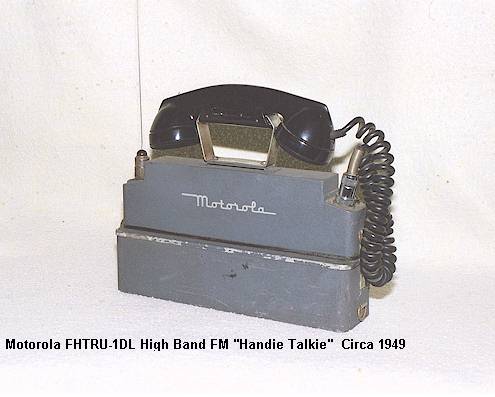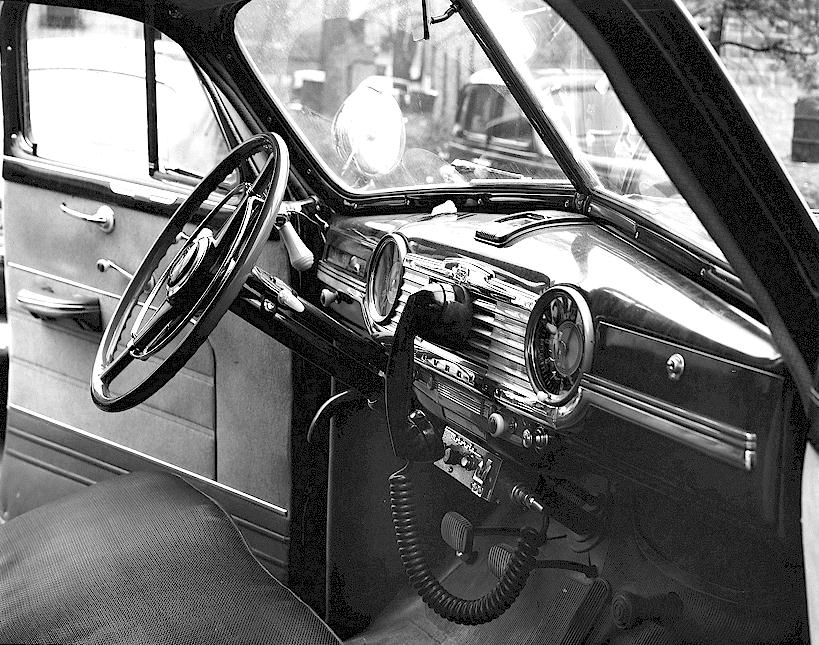Public Safety Grade Communications Radios: Then and Now
By Ray Grimes
Police radios in the United States first appeared around the late 1920s. The first efforts were fraught with challenges, where the Department of Commerce (preceding

Motorola FHTRU-1DL High Band FM “Handie Talkie” (circa late 1949)

Typical Early Police Mobile Radio Installation (circa 1940).
the Federal Communications Commission) was not supportive of the concept or value of police radios.1 Radio equipment drift (frequency instability of transmitters and receivers) severely degraded reception reliability and clarity. In 1923 the first two-way mobile police radio was developed and placed in service for the Victoria Police Department, Australia, with an Amplitude Modulation (AM) mobile transmitter taking up the entire back seat of the automobile.
In 1928 the Detroit Police Department developed and installed one-way AM receivers in patrol cars (AM Radio Station KOP), thanks to the technical knowledge and insight of Patrolman Kenneth Cox and Bob Batts, an engineering student (and years later, the Director of Product Services for Motorola, Inc.). In 1933 the Bayonne, New Jersey, Police Department developed and constructed a practical two-way VHF AM mobile two-way police radio system, thanks to Lt. Vincent J. Doyle and Frank Gunther, a radio engineer (in 1932 he developed and demonstrated the first two-way aircraft radio system). The Bayonne Police radio system proved the value and benefits of police two-way mobile communications, opening the door for other police agencies to follow.2
Early mobile police radio receivers were simply consumer-grade tunable AM broadcast car radios. One-way police radio dispatches occurred on the AM broadcast band by sharing entertainment radio station transmitters.3 The “Guy Lombardo and his Royal Canadians Band” broadcast might be interrupted by a “Calling All cars” police broadcast before resuming the music program or a message from the sponsor. Early car radios were primitive, consisting of fragile and unreliable vacuum tubes which operated off an independent dry storage battery bank, using the automobile cloth-covered (copper mesh) rooftop panel as an antenna system. Early cars didn’t have built-in spark plug and generator noise suppression, so radio reception was seriously degraded when the vehicle was running. AM broadcasting offered little rejection of manmade and environmental radio interference. Vibration was another big problem, where these fragile radio receivers would jump to another receiving frequency, frequently having to be manually retuned to the police broadcast. Vibration caused components in these fragile car radios to fatigue and literally fall off. Around the late 1920s and 1930s ham radio operators began employing crystal controlled transmitters to improve stability and reliability. That technology was soon applied to police radio transmitter and receiver systems, greatly improving reliability and dependability of early police radio system, virtually eliminating “frequency drift.”4
Motorola a Pioneer
In the early days of police radio, many of the American automobile radio manufacturers such as the Galvin Manufacturing Company (Motorola), American Bosch, RCA, Link, and Philco ventured into making modified car entertainment radios for use as police radio mobile receivers.5 All of these early radios lacked reliability and performance for critical police communications use. In 1936, Galvin manufacturing Company (Motorola) introduced the P-69 “Police Cruiser” receiver, which was designed around the entertainment radio line but was truly a police grade product.6 Even though the Motorola P-69 was tailored for the police mobile communications market, it was still very much of a car radio, having a small control head (steering wheel column-mounted) with an uncalibrated knob to tune-in police calls. Sometime around 1930, crystal frequency control was being implemented for police radios, making these systems more reliable and robust. World War II played a large part in catapulting radio communications technology forward in very few years. Radio manufacturers had the resources and incentive to produce better radio equipment that would work reliably in the field, under the worst conditions.
After WW II, the Federal Communications Commission opened up Low Band frequencies for police radio usage, with fire service communications following shortly. Low Band spectrum delivered very good mobile and fixed station local coverage, and when coupled with Frequency Modulation (FM), which inherently rejects electrical noise, a winning combination of highly effective police communications systems resulted. Later on, in the 1950s and 1960s VHF High band and UHF were implemented, mainly for police and commercial radio systems, often with repeaters that extended coverage significantly with exceptional reliability. These higher frequency bands worked well enough to facilitate use of handheld portables, supporting in-building coverage. Decades later, 700 MHz and 800 MHz were added to the bands available to public safety, affording communications reliability, blanket coverage and system features not envisioned before.
Going back to the discussion of radio equipment reliability and stability, we must keep in mind that while new higher frequency police radio bands were being created, they not only offered improved local coverage characteristics but at the same time technology made quantum jumps forward. Radio manufacturers over the years overcame equipment stability and reliability problems, tackling temperature-related failures and frequency drift that were resolved through the development of military-grade ruggedized vacuum tubes and high-quality components made of pure materials that exhibited excellent temperature stability characteristics. The mechanical vibration problem was most evident in police motorcycle radio installations in the 1940s through the 1960s where the early police bikes would literally shake internal radio parts to destruction. Reliability improvements (thanks to WW II military radio engineering) produced captive tube sockets and power/control cable connectors that wouldn’t fall off in service from vibration and mechanical shock.
Enter Semiconductors
Going forward to the 1960s and 1970s, semiconductors were introduced in vacuum tube mobile radios, with diodes replacing tube rectifiers, detectors, and audio circuits, with transistors replacing vibrators in DC power supplies. While semiconductors greatly improved these products, they were much more susceptible to heat and overvoltage conditions than their vacuum-tube era counterparts. In fact, early power transistors used in 6V and 12V mobile power supplies really didn’t like sub-freezing conditions and would struggle with startup in switching power supply configurations. Power transistors would quickly overheat from excess inrush current and literally explode, producing a sound like a shotgun blast as the transistor top caps exited the mobile radio. As semiconductor technology advanced, most of the earlier operating limitations and faults were eliminated through use of high-quality semiconductors and good engineering design practices, producing lightweight, small-sized, low-current drain radio products with countless useful features.
Materials used to construct two-way radios played a significant role in the success or failure of a product. Bakelite circuit boards were popular for use in two-way radio production from the 40s through the 70s. Bakelite is an interesting composition of phenolic resin and a filler, which was formerly asbestos and later, wood chips. Bakelite was a fair insulation material and cheap to produce but lacked strength and resistance to heat and moisture. Thanks to the aerospace program, later electronics circuit boards were developed, which were composed of high-grade epoxies and fiberglass, eliminating most all of the failures of their Bakelite counterparts.
Fairly effective portable radio transceivers were introduced in WW II but weren’t really useful or practical for police and fire service until the 1950s when Motorola introduced the HT Handie-Talkie©, an all-miniature vacuum tube, dry battery operated Low Band or VHF transceiver.These lunchbox-sized, vacuum tube portableradios afforded real portability but had regular mechanical and electrical failures due to the state of the art at the time, not to mention that the dry batteries were depleted in hours and had to be regularly replaced in the field.
Maintenance Is Mandatory
Radio communications systems in the early days through the 70s was fraught with reliability problems, requiring regular transmitter and receiver frequency adjustments, regular replacement of vacuum tubes, and numerous repairs. These mobile radio sets couldn’t stand up to a harsh operating environment. In the 1930s, the Fred. M. Link Company was known as the leader in police radio. Paul Galvin was frustrated in knowing that his competitor held the secret to police radio reliability and performance in this fledgling business. Galvin’s mobile radio receivers were subject to frequent misadjustment and failure, unlike Link’s police radio products. Galvin soon discovered that the missing ingredient was regular radio equipment maintenance by qualified radio technicians. In fact, Link would only sell his police mobile receivers to agencies that employed their own qualified technicians.7
Paul Galvin took Link’s concept one step further, building the Galvin Manufacturing Company (Motorola, Inc.) reputation for product performance and reliability in the police radio market, not just by making good products but by introducing the “Programmed Maintenance” concept. Galvin quickly realized that these early police radios needed regular adjustments and attention to maintain their performance. In the early days, Galvin’s factory engineers would visit police agencies bi-weekly to adjust frequencies, realign equipment and to replace vacuum tubes.7
Thanks to great advances in solid state technology, mobile and portable radio equipment has improved to the degree that under normal operations, very little maintenance is required at all. In fact, thanks to solid-state frequency synthesizers (that replace radio crystals), mobile and portable transmitter and receiver frequency stability these days almost equals that of the test equipment used to calibrate it. Modern top-end public safety equipment is designed to meet the MIL-810-C specification for ruggedness and reliability in harsh operating environments. Some top-end portable radio equipment is also submersible, allowing it to operate under water or to be immersed (as in Fire and Life Guard services). These days we take for granted the reliability and performance of modern portable and mobile equipment but it was only 4 decades ago that vacuum tubes were the mainstay of mobile radio communications. Just imagine the mobile and portable products we’ll have in just a decade!
Ray Grimes is APCO/CPRA Senior Member, Pegasus Telecommunications Consulting Group-Owner, Executive Director, Orange County Sheriff’s Museum & Education Center, Orange County Sheriff’s Department Assistant Director-Chief Engineer (retired), Motorola, Inc. Senior Staff Engineer (retired).
Footnotes:
- “Critical Connection, The MSS Story”. Kathi Ann Brown, Motorola University Press, 1992. P. 22, Calling All Cars, 4.
- Engineering and Technology History Wiki. (Bayonne PD).
http://ethw.org/Milestones:Two-Way_Police_Radio_Communication,_1933
- BK Technologies, West Melbourne, Florida.
https://www.bktechnologies.com/the-origin-of-two-way-police-radio-communication/
- “Critical Connection, The MSS Story”. Kathi Ann Brown, Motorola University Press, 1992. P. 23, Calling All Cars, 2.
- Development of the Commercial market for Crystals, reprint from IEEE Proceedings of the 1996 IEEE International Frequency Control Symposium (pp 58-65). http://www.bliley.net/XTAL/Industry-Hams.html
- Motorola Early Land mobile Radio Equipment Index, 1938-1946. Geoff Fors, WB6NVH, Para. 2. http://www.wb6nvh.com/Moto/Motadata.htm
- Motorola Early Land mobile Radio Equipment Index, 1938-1946. Geoff Fors, WB6NVH, Para. 3. http://www.wb6nvh.com/Moto/Motadata.htm
- “Critical Connection, The MSS Story”. Kathi Ann Brown, Motorola University Press, 1992. P. 39, “Hard Lessons”, 5.
- Historical Photos thanks to the Geoff Fors website: http://wb6nvh.com/

